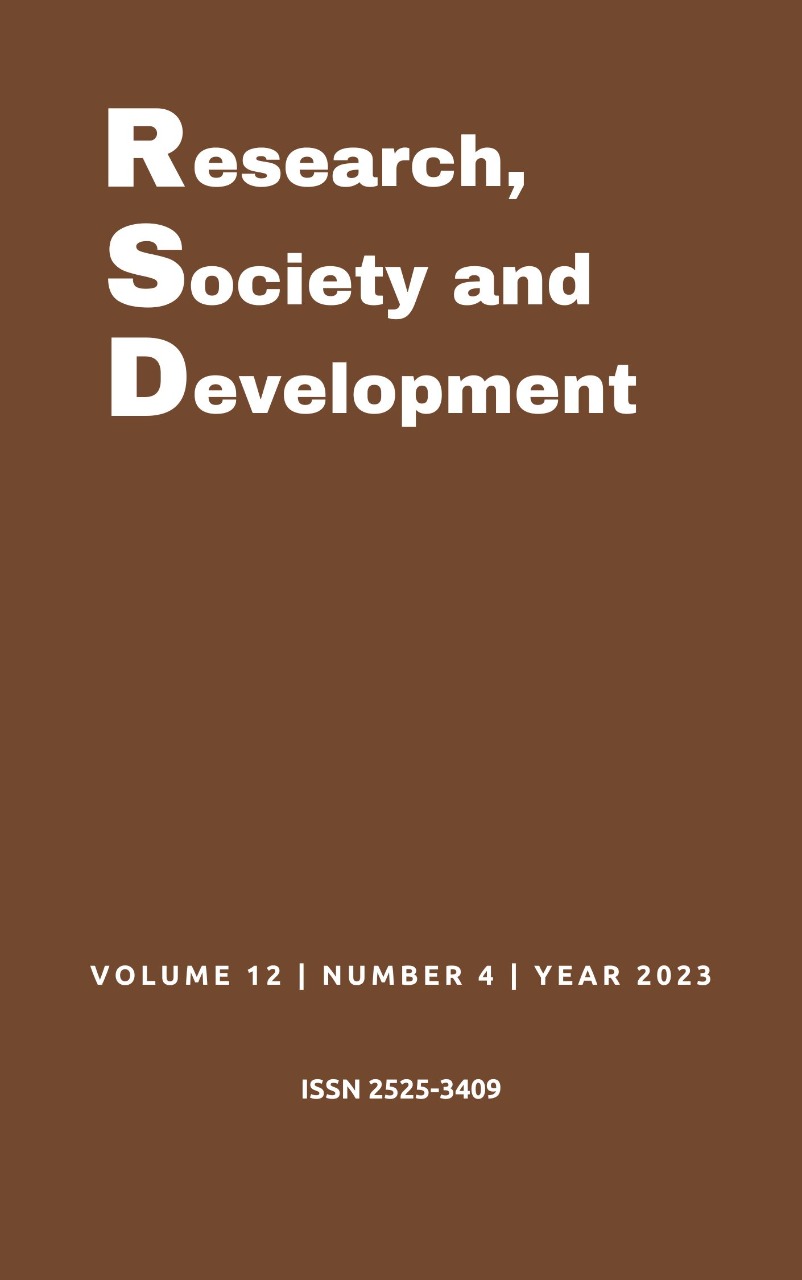Abordajes y recursos fisioterapéuticos en el Servicio de Atención Domiciliaria (SAD) del Programa Mejor en Casa: revision integradora
DOI:
https://doi.org/10.33448/rsd-v12i4.41156Palabras clave:
Fisioterapia, El parto, Parto humanizado, Humanización de la asistencia.Resumen
Este estudio de revisión integradora tuvo como objetivo describir los enfoques y recursos de fisioterapia en el SAD del Programa Mejor en Casa. La búsqueda de datos se realizó en las bases de datos PubMed, Biblioteca virtual en salud (BVS), Literatura Latino-americana y del Caribe en Ciencias de la Salud (LILACS), SCIELO y Google académico con los descriptores: Fisioterapia, Tratamiento domiciliario, Servicio de Asistencia Domiciliaria, Asistencia domiciliaria, y, utilizando estrategias de combinación de los términos. El cribado de los artículos encontrados se realizó mediante la lectura del título, la lectura del resumen, e incluso en caso de duda, el artículo fue leído en su totalidad y seleccionado por los criterios de inclusión y exclusión. Después de filtrar y analizar las publicaciones, 8 artículos fueron seleccionados para esta revisión. Fue evidente en esta revisión que son muchos los contextos vividos en el trabajo del fisioterapeuta en el SAD y muchos son los recursos utilizados por él, dentro de un papel importante dentro del equipo multidisciplinar. También fue posible plantear los desafíos, avances y potencialidades de este trabajo con los pacientes y cuidadores domiciliarios. El fisioterapeuta en el SAD actúa en el contexto del niño al anciano, del paciente con necesidades neumofuncionales al paciente en cuidados paliativos, con técnicas y recursos, sean manuales, eléctricos, kinesioterapéuticos, mecánicos u orientadores. En este escenario, los estudios utilizados y los revisores de esta investigación señalan la necesidad de nuevas investigaciones sobre el tema para fortalecer la práctica basada en la evidencia.
Referencias
Aguiar, C. M., Souza F. L. & Cunha, F. N. A. M. (2015). A experiência do fisioterapeuta no programa Melhor em Casa em Sobral, CE. Relato de caso. EFDeportes.com, Revista Digital. Buenos Aires, año 20, 208, 2, (17).
Alencar, A. M. C. (2018). Avaliação do uso de tecnologias no atendimento domiciliar de crianças e adolescentes na cidade de Curitiba. R. Saúde Públ. Paraná. 1(1):11-19.
Araujo, R. C. G. (2018). Programa Melhor Em Casa: processo de trabalho da equipe multiprofissional. Dossiê de Enfermagem e Educação. 14(4), 7.
Carnaúba, et al. (2017). Caracterização clínica e epidemiológica dos pacientes em atendimento domiciliar na cidade de Maceió, AL, Brasil. Rev. Bras. Geriatr. Gerontol, 20(3): 353-363.
Costa, A. C. A. D. (2017). A intervenção fisioterapêutica no serviço de atenção domiciliar - relato de experiência. V Congresso Internacional de Envelhecimento Humano.
Dias, et al. (2017). Atenção domiciliar no âmbito da reabilitação e prática centrada na família: aproximando teorias para potencializar resultados. Rev Ter Ocup Univ São Paulo. 28(2): 206-13.
Ferreira, et al. (2017). Complexidade do cuidado na atenção domiciliar. Ed 1. Hospital Alemão Oswaldo Cruz. 2017.
Formiga, D. C. R.& Cavalcanti, P. B. (2019). Estudo bibliográfico sobre a prática do fisioterapeuta em cuidados Paliativos. Repos UFPB.
Kruscb, et al. (2021). Sobrevida e funcionalidade em idosos na atenção domiciliar. Saud Pesq, 14(4): 817-825.
Lopes, J. M. C. & Souza, A. I. (2015). A gestão do cuidado na atenção domiciliar. Módulo 3. UFSC. Governo Federal. Ministério da Saúde. 2015.
Martins, M., Blais, R. & Miranda, N. N. (2008). Avaliação do índice de comorbidade de Charlson em internações da região de Ribeirão Preto, São Paulo, Brasil. Cad. Saúde Pública, 24(3):643-652.
Mendes et al. (2008). Revisão Integrativa: Método De Pesquisa Para A Incorporação De Evidências Na Saúde E Na Enfermagem. Texto Contexto - Enferm . 17(4), 758 – 764.
Oliveira, S.G. & Kruse, M. H. L. (2017). Melhor Em Casa: Dispositivo De Segurança. Texto Contexto Enferm, 26(1):e2660015.
Procópio, et al. (2019). Atenção Domiciliar no âmbito do Sistema Único de Saúde: desafios e potencialidades. Saúde debate, 43 (121).
Reis, et al. (2021). Perfil de pacientes e indicadores de um serviço de atenção domiciliar. Enfermagem Brasil, 20, 2.
Santana, J. & Carvalho, F. L. (2021). Desafios Do Atendimento Fisioterapêutico Na Atenção Básica No Período De Pandemia Da Covid-19: o que mudou? REPOS UniAGES, Paripiranga. 2021.
Silva, et al. (2019). Caracterização clínica e epidemiológica de pacientes atendidos por um programa público de atenção domiciliar. Enferm. Foco, 10(3): 112-118.
Silva, E. B. & Santos, J. C. (2019). A importância da aproximação entre o fisioterapeuta e o cuidador de pacientes sob cuidados domiciliares. Repos FAEMA.
Souza, M. S., Ribeiro, M. D. A. & Ribeiro, M. D. A. (2018). Atuação do fisioterapeuta no programa melhor em casa. Rev Pesq Saúde, 19(1): 24-28.
Souza, L. C. A. (2022). A importância do programa melhor em casa no atendimento ao paciente idoso: relato de experiência. Brazilian Journal of Development, 8(7), 48981-48988.
Teixeira, M. C. S. & Castro, L. A. S. (2019) Pacientes com traqueostomia: conhecimentos, atitudes e práticas das equipes do serviço de atenção domiciliar. Rev SUSTINERE, 7(2).
Descargas
Publicado
Número
Sección
Licencia
Derechos de autor 2023 Daise dos Santos de Oliveira; José Rafael da Conceição Brito; Thauan Narciso de Lima Ferro; Ahyas Sydcley Santos Alves

Esta obra está bajo una licencia internacional Creative Commons Atribución 4.0.
Los autores que publican en esta revista concuerdan con los siguientes términos:
1) Los autores mantienen los derechos de autor y conceden a la revista el derecho de primera publicación, con el trabajo simultáneamente licenciado bajo la Licencia Creative Commons Attribution que permite el compartir el trabajo con reconocimiento de la autoría y publicación inicial en esta revista.
2) Los autores tienen autorización para asumir contratos adicionales por separado, para distribución no exclusiva de la versión del trabajo publicada en esta revista (por ejemplo, publicar en repositorio institucional o como capítulo de libro), con reconocimiento de autoría y publicación inicial en esta revista.
3) Los autores tienen permiso y son estimulados a publicar y distribuir su trabajo en línea (por ejemplo, en repositorios institucionales o en su página personal) a cualquier punto antes o durante el proceso editorial, ya que esto puede generar cambios productivos, así como aumentar el impacto y la cita del trabajo publicado.


